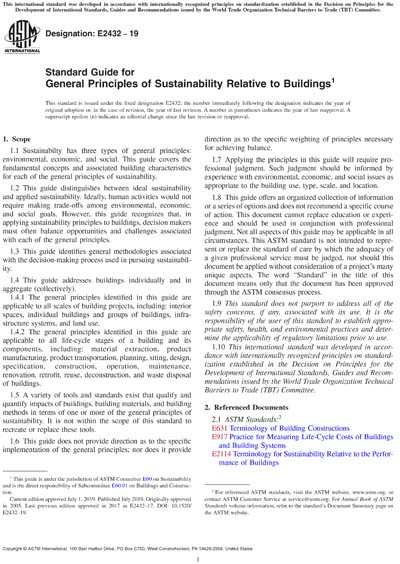Historical
ASTM E2432-19
Standard Guide for General Principles of Sustainability Relative to Buildings
1.1 Sustainabilty has three types of general principles: environmental, economic, and social. This guide covers the fundamental concepts and associated building characteristics for each of the general principles of sustainability.
1.2 This guide distinguishes between ideal sustainability and applied sustainability. Ideally, human activities would not require making trade-offs among environmental, economic, and social goals. However, this guide recognizes that, in applying sustainability principles to buildings, decision makers must often balance opportunities and challenges associated with each of the general principles.
1.3 This guide identifies general methodologies associated with the decision-making process used in pursuing sustainability.
1.4 This guide addresses buildings individually and in aggregate (collectively).
1.4.1 The general principles identified in this guide are applicable to all scales of building projects, including: interior spaces, individual buildings and groups of buildings, infrastructure systems, and land use.
1.4.2 The general principles identified in this guide are applicable to all life-cycle stages of a building and its components, including: material extraction, product manufacturing, product transportation, planning, siting, design, specification, construction, operation, maintenance, renovation, retrofit, reuse, deconstruction, and waste disposal of buildings.
1.5 A variety of tools and standards exist that qualify and quantify impacts of buildings, building materials, and building methods in terms of one or more of the general principles of sustainability. It is not within the scope of this standard to recreate or replace these tools.
1.6 This guide does not provide direction as to the specific implementation of the general principles; nor does it provide direction as to the specific weighting of principles necessary for achieving balance.
1.7 Applying the principles in this guide will require professional judgment. Such judgment should be informed by experience with environmental, economic, and social issues as appropriate to the building use, type, scale, and location.
1.8 This guide offers an organized collection of information or a series of options and does not recommend a specific course of action. This document cannot replace education or experience and should be used in conjunction with professional judgment. Not all aspects of this guide may be applicable in all circumstances. This ASTM standard is not intended to represent or replace the standard of care by which the adequacy of a given professional service must be judged, nor should this document be applied without consideration of a project’s many unique aspects. The word “Standard” in the title of this document means only that the document has been approved through the ASTM consensus process.
1.9 This standard does not purport to address all of the safety concerns, if any, associated with its use. It is the responsibility of the user of this standard to establish appropriate safety, health, and environmental practices and determine the applicability of regulatory limitations prior to use.
1.10 This international standard was developed in accordance with internationally recognized principles on standardization established in the Decision on Principles for the Development of International Standards, Guides and Recommendations issued by the World Trade Organization Technical Barriers to Trade (TBT) Committee.
ASTM International [astm]

